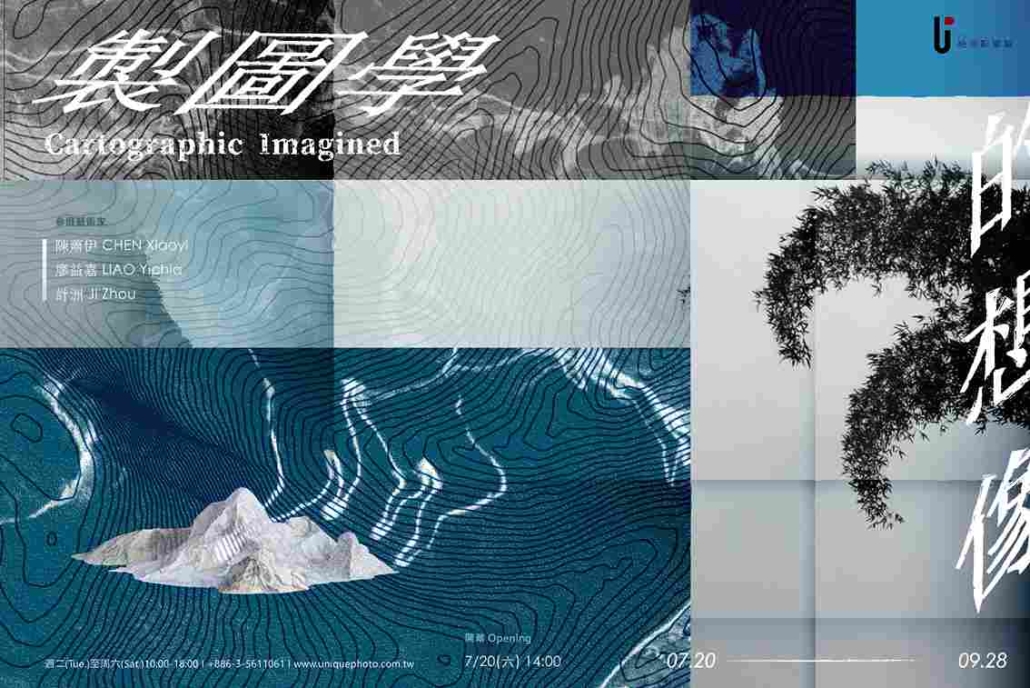EXHIBITIONS
Exhibition ─ Current
Cartographic Imagined
Cartographic Imagined
Duration|2024.07.20~09.28
Opening|2024.07.20 (Sat.) 14:00
Artists|CHEN Xiaoyi, LIAO Yichia, JI Zhou
Venue|UP Gallery Ground Floor
“Read me carefully, follow me closely, doubt me not. I am the earth in the palm of your hand. Without me, you are alone and lost.” – BERYL MARKHAM, 1983
Exploring the rich history of cartography unveils humanity’s enduring fascination with mapping the world we inhabit, from ancient cave drawings to today’s sophisticated Geographic Information Systems (GIS) and ubiquitous tools like Google Maps. Cartography, from a scientific standpoint, offers us a tangible comprehension of our environment, delineating borders and pathways for exploration. It serves as indispensable geographical documentation and archival data, contributing to scientific epistemology, while also wielding cultural and political influence in shaping global perspectives.
Amidst the evolution of cartography, J.B. Harley’s critique underscores a perceived loss of artistry and its social implications in mapping. Traditionally valued for their scientific accuracy, maps are fundamentally human constructs that interpret landscapes through a lens of representation. In JI Zhou’s “Maps” series, intricate maps are transformed from their usual flat representations into textured vistas resembling heaves of mountain ranges. These visually captivating artificial landscapes challenge our perception of reality, grounded as they are in the traditional conventions of cartography. While color blocks delineate territories and latitude and longitude provide directional bearings, the representation of oceans and islands underscores the constructed nature of these codes. Zhou’s stereoscopic maps prompt us to ponder how these human-created symbols and constraints influence our understanding. They highlight the paradox that while maps strive for scientific accuracy, they also evoke realms of pure imagination.
LIAO Yichia takes a completely opposite approach to Zhou with his new series “Shihlin Weir” and “Peaks.” Instead of using maps as source material, he employs a primitive form of mapping: photography. He simply captures pieces of “land”, uninterested in aerial shots or pre-researched planes, and is fascinated by how humans can map the world emotionally and poetically. By intertwining stones, natural oil stains on water surfaces, and mountain peaks as pointers and guideposts, he creates his own unique fictional maps. These elements of nature become micro representations of actual mountain ranges, rivers, and borders. Like his newfound tokens, he moves and reshapes them with distinct angles, forming miniature representations of idealized maps through straight photography. Particularly those in “Shihlin Weir” photographed in Miaoli, Taiwan hold personal and cultural significance, making his mapping process realistic in execution but delicate and figurative in concept.
On the other hand, CHEN Xiaoyi’s work focuses on the geological timescale, with her exploration and creations centered in the Hengduan Mountains. Her starting point is abandoned mining areas, now mostly suspended spaces. In her piece “A Star Atlas from Hengduan’s Core,” she uses her stylus to mark ore deposits, creating a starry sky effect through an oriental folding screen installation. The “Kataskapos” series adopts a contour mapping technique, simultaneously marking abandoned trails. Tracking these sparse and dense lines evokes the warmth of human fingerprints. Throughout these processes, the artist’s hand is palpable, conveying a complex connection to the land. In “Reverberation Guide,” she further suggests that sounds may be part of the mapping process, often experienced during the vast task of cartographing these mountains. She attempts to describe the changes experienced in the mountainous areas, with the suspended spaces’ desolation echoing the footprints of past human activity. These remnants, like blank spaces on a map, take on new forms of existence through the artist’s personal cartography.
In this exhibition, UP Gallery warmly invites you to explore the diverse and imaginative ways artists interpret and represent our world. Through the works of JI Zhou, LIAO Yichia, and CHEN Xiaoyi, experience the intersection of cartography and art, where scientific precision meets emotional depth, challenging our perceptions and expanding our understanding of mapping and the landscapes it represents. Echoing Markham’s sentiment, maps are indeed more than mere tools; in the hands of these artists, however, they take on new meanings and forms, becoming guides for our emotional states and shaping how we perceive the world around us.
About the Artists
CHEN Xiaoyi (b.1992)
CHEN Xiaoyi was born in Sichuan, China. She received an MA Photography from London College of Communication in 2014, and currently lives and works in Chengdu. Integrating multiple forms and media, the motifs of her works often derive from reflections on nature and existence at multiple scales. The recent series, she focuses on the Hengduan Mountains in southwestern China. Taking the present day as a starting point, the artist searches for the intersection of different forms of existence within the long durée of geological and cosmological time. In her artworks, the relics of the mining industry are revealed as the embodiment of narratives, descriptions, and knowledge systems from multiple perspectives. CHEN Xiaoyi has exhibited internationally; she was awarded the Three Shadows Photography Award in 2015, China’s most prestigious photography prize, and named one of Asia’s 30 Artist under 30 by Forbes magazine 2017. Her recent works have been exhibited at the Vevey Image (Switzerland), LA NUU photo festival (Spain), La Biennale de la Photographie de Mulhouse (France), Calling/re-Calling-Culture city of east Asia (Japan), Jimei x Arles International Photo Festival (China), Lianzhou Foto (China), Museum Folkwang (Germany), Benaki Museum (Greece), Guangdong Times Museum (China), OCAT Shenzhen (China), Power Station of Art (China), Three Shadows Photography Art Centre (Beijing), A4 Art Museum (China) etc.
LIAO Yichia (b.1961)
LIAO Yichia practices photography and installation art is a significant figure in the field of Taiwan’s contemporary art photography. Liao’s fascination with time since the age of four has been the main reason for becoming an artist and embracing photography, a medium that has the ability to capture, dissect, and manipulate time. His artistic practice surrounds the relationship between time and the universe. In each series, he extracts a certain element of the world and probes its relationship with time. His early embracement of digital photography has enabled him to expand this ideology through digital manipulation. Having a vigorous background in analog photography and experiences in the darkroom he is highly influenced by modernist values. Yet he adopts issues and conveys his works in a conceptual and critical manner, resulting in an inevitable tension of conceptual and (extravagantly beautiful) subjectivity that coexists in his works which has become his signature style. His works have been exhibited in Taiwan, Shanghai, Hong Kong, London, and Melbourne. They have been featured in media outlets such as The Guardian and The Times in the UK, and have been collected by the Art Bank, the Art and Culture Center of National Yang Ming Chiao Tung University, as well as numerous private collectors.
JI Zhou (b.1970)
JI Zhou was born in Beijing and has been learning painting since childhood. In an era driven by high technology that is constantly evolving yet becoming increasingly chaotic, he chose photography as the main medium for his work after graduating from the Central Academy of Fine Arts. He has created numerous photographic series, including “Construction Site,” “Dust,” “Map,” “Model,” and “Real Illusion.” He believes that photography can accurately express his feelings about contemporary society, particularly his reflections on the relationship between the dual concepts of reality and fiction. His works have been exhibited worldwide, including at the Paper Museum in Angoulême, France; the Boghossian Foundation in Brussels, Belgium; the IVAM – Institut Valencià d’Art Modern in Valencia, Spain; the Tang Contemporary Art Center in China; the Ullens Center for Contemporary Art; and the Three Shadows Photography Art Centre.



